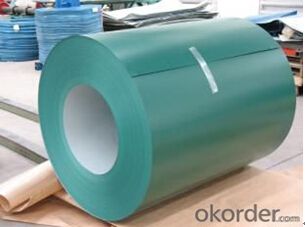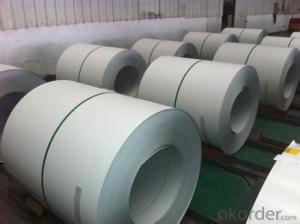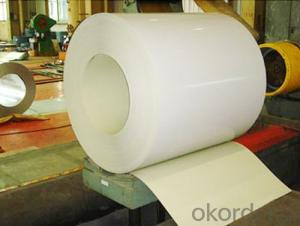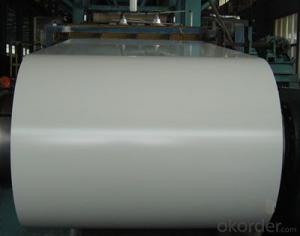Pre-Painted Steel Coil, High Quality White Color,PPGI
- Loading Port:
- Shanghai
- Payment Terms:
- TT OR LC
- Min Order Qty:
- 200 m.t.
- Supply Capability:
- 20000 m.t./month
OKorder Service Pledge
OKorder Financial Service
You Might Also Like
1.Structure of Pre-painted Galvanized/Aluzinc Steel Coil Description
With GI (aluzinc) as base metal, after pretreatment (degrease and chemical treatment) and liquid dope with several layers of color, then after firing and cooling, finally the plate steel is called pre-painted galvanized (aluzinc) steel. Pre-painted galvanized steel is good capable of decoration, molding, corrosion resistance. 2.Main Features of the Pre-painted Galvanized/Aluzinc Steel Coil
• Capability of decoration, molding, corrosion resistance
• Workability, durability
• Excellent heat resistance performance
• High strength
• Good formability
• Good visual effect
3.Pre-painted Galvanized/Aluzinc Steel Coil Images

4.Pre-painted Galvanized/Aluzinc Steel Coil Specification
Quality standar: JIS G3312 CGCC & CGLCC
Paint thickness for top side : 5 micron primer + (10-20) microns modified polyester, green color.
Paint thickness for back side: (5-10) microns Epoxy
Hardness of P: Both soft and hard quality are available
Surface finish: with or without protect film
Thickness : 0.14-1.20 mm
Width : 914mm, 1000mm, 1220mm and 1250mm, thickness 600-1250mm is available
Finish by coil or sheet: Both sheet and coil are available
8Zinc coating: 60-275G/M2, both sides
Weight per coil: 4-6 tons, also can be upon customer's requirements
Max loading weight in one 20ft container : 25 tons generally
5. FAQ of Pre-painted Galvanized/Aluzinc Steel Coil
We have organized several common questions for our clients,may help you sincerely:
1. What is the minimum order quantity ?
Our MOQ is 50mt for each size. And we will consider to give more discount if you make big order like 1000 tons and more. Further more, the more appropriate payment term your offer the better price we can provide.
- Q:How do the sandpaper grits compare with different coarse levels of steel wool? For example, I'm finishing a homemade entertainment center, and using a tinted polyurethane, and it says to use 000 grade steel wool, but mine is #3, could I use some sanpaper instead, and what grit?
- 150 grit is standard for final sanding for poly. You could use 220 if you finish with something thinner like lacquer of if that's all you have. Even finer would work but not do much sanding.
- Q:What is the difference between regular steel stainless steel? Why does steel rust but stainless wont? Is stainless some kind of alloy or something? Any knowledgeable input would be great. Thanx!
- There are many things in life that I wonder about. Being in the steel industry and selling stainless steel I have at one point in my life asked myself, why do they call it stainless steel? What makes it stainless? It doesn't take much to find out but here is a very brief synopsis of what makes stainless steel stainless so that you can check one more thing off the list in your quest for knowledge. Stainless Steel might or might not have been invented by a man named Harry Brearley in 1912. Steel has been around for hundreds of years but it hasn't always been stainless. Only after the exact combination of elements had been achieved did we start calling a certain type of steel stainless. His magic potion contained the keys to what is now called stainless steel. That being said, the true inventor of stainless is still an ambiguous cloud at best. However, this isn't a discussion on WHO invented stainless but what stainless is and how it's actually stainless. Here is a great article posted by British Stainless Steel Association in regards to the history of stainless as a whole, see here. So what is in this magic potion that makes a steel not stain or rust? As most of us know if you leave regular steel or metal out in the elements it will rust, oxidize, or stain. Why does stainless not stain? When Harry Brearley Brearley created a steel with 12.8% chromium and 0.24% carbon, that was believed to be the first ever stainless steel. Chromium is the element in stainless that improves the corrosion resistance by forming a chromium oxide film on the steel. This very thin layer, is what allows the steel to be impermeable to rust or staining and when placed under the right conditions, it can also be self-repairing to a certain extent. There you have it. The answer is Chromium. Chromium is the element when mixed w/other elements in the proper amounts to form the thin layer that protects the steel from rusting, staining or corroding. Hope that helps you in your pursuit of knowledge.
- Q:I want to know what to my wash stainless fridge door with before applying the stainless steel polish.
- I just use a regular spray on kitchen cleaner like 409. Then after I do that to prevent the streaks, just use baby oil. Put a tiny bit on a paper towel and wipe it over the doors. I learned this from online and from a pal that is in the navy. They can't have streaks on anything for navy inspections.
- Q:What are the common defects in steel coils?
- There are several common defects that can occur in steel coils during the manufacturing or handling processes. These defects can affect the quality and performance of the steel, and it is important to identify and address them to ensure the production of high-quality steel products. Some of the common defects in steel coils include: 1. Edge waves or buckles: This defect occurs when the edges of the steel coil become wavy or buckled. It can be caused by improper winding, uneven cooling, or excessive tension during the manufacturing process. Edge waves can lead to difficulties in further processing and affect the appearance of the final product. 2. Coil breaks: Coil breaks are longitudinal breaks or cracks that occur in the steel coil due to excessive strain or stress. These breaks can be caused by improper winding, uneven cooling, or excessive tension during the manufacturing process. Coil breaks can lead to product quality issues and are a major concern in the steel industry. 3. Surface defects: Surface defects in steel coils can include scratches, pits, or stains on the surface. These defects can be caused by improper handling, surface contamination, or inadequate cleaning processes. Surface defects can affect the appearance of the steel and may also lead to corrosion or other performance issues. 4. Slivers: Slivers are thin strips or flakes that can peel off from the edges of the steel coil. They can be caused by poor edge trimming, improper handling, or defects in the rolling mill. Slivers can cause difficulties in further processing and may also affect the surface quality of the final product. 5. Weld defects: In steel coils that are made by welding multiple strips together, weld defects can occur. These defects can include incomplete fusion, porosity, or cracks in the weld area. Weld defects can weaken the steel and affect its mechanical properties, making it unsuitable for certain applications. 6. Shape defects: Shape defects in steel coils can include camber, coil set, or crossbow. These defects can be caused by uneven cooling, improper winding, or tension variations during the manufacturing process. Shape defects can make it difficult to process the steel and may lead to dimensional inaccuracies in the final product. It is essential for manufacturers and users of steel coils to be aware of these common defects and take appropriate measures to prevent or mitigate them. Quality control measures, proper handling procedures, and regular inspections can help in identifying and addressing these defects to ensure the production and use of high-quality steel products.
- Q:How are steel coils used in the manufacturing of storage racks?
- Steel coils are used in the manufacturing of storage racks by being cut into smaller, more manageable pieces that are then shaped and welded into the desired rack structure. The strength and durability of the steel coils make them an ideal material for supporting heavy loads and ensuring the stability of the storage racks.
- Q:I have heard using the BRASS casing is the best thing for an AR-15? Should i just use Brass or Steel?
- Two reasonable answers here. But let me say this...I just don't like the idea of steel touching steel at a high rate of speed (like when it's being cycled in and out of the chamber of a rifle). I can't help but feel that some sort of erosion is going to occur to the chamber of the rifle - which obviously isn't a good thing. If it were me, I would stick with firing brass casings only. The only gun I would fire steel casings through would be a cheaper SKS
- Q:How are steel tape measures installed?
- Today, I met similar situations at work! Accidentally pull the head, and then automatically can not go back, after opening, winding, after installation, can not automatically withdraw! After a long time, we suddenly noticed that we neglected a small place!
- Q:How are steel coils loaded onto trucks or containers?
- Steel coils are typically loaded onto trucks or containers using specialized equipment such as coil lifters or coil hooks. These devices safely secure the coils and allow them to be lifted and positioned onto the truck or container. The coils are then secured in place using straps or other restraints to prevent them from shifting during transportation.
- Q:How are steel coils used in the production of heating systems?
- Steel coils are used in the production of heating systems in various ways. One of the main uses of steel coils in heating systems is in the construction of heat exchangers. Heat exchangers play a crucial role in transferring heat from one medium to another within the heating system. The steel coils are typically formed into a series of tubes or fins, which provide a large surface area for efficient heat transfer. In a typical heating system, hot gases or liquids pass through these steel coils, while another medium, such as air or water, flows over or through the coils. This allows for the transfer of heat energy from the hot medium to the cooler medium, thereby effectively heating the air or water for distribution throughout the heating system. Another use of steel coils in heating systems is for the production of radiant heating panels or floor heating systems. In these applications, the steel coils are typically embedded within a panel or underneath the flooring. When electricity or hot water is passed through the coils, they heat up, radiating heat to the surrounding environment. This type of heating system is particularly efficient and provides a comfortable and even distribution of heat. Furthermore, steel coils are also used in the manufacturing of heating system components such as boilers, furnaces, and heat pumps. These components often require the use of steel coils for their heat transfer capabilities and durability. The coils are integrated into the design of these heating system units to ensure efficient and reliable heat generation and distribution. Overall, steel coils play a crucial role in the production of heating systems by enabling efficient heat transfer, providing durability, and facilitating the generation and distribution of heat.
- Q:I was curious to what type of steel I should get if I wanted something that kept its edge longer than 154cm but is still just as stainless. I don't know much about knife steels inform me please?
- If you want a good quality knife, stay away from Stainless, I would suggest one that is a mix of high and low carbon steel, high carbon holds the edge, but is brittle, low carbon is more malleable, which prevents from breaking when used.
1. Manufacturer Overview |
|
|---|---|
| Location | |
| Year Established | |
| Annual Output Value | |
| Main Markets | |
| Company Certifications | |
2. Manufacturer Certificates |
|
|---|---|
| a) Certification Name | |
| Range | |
| Reference | |
| Validity Period | |
3. Manufacturer Capability |
|
|---|---|
| a)Trade Capacity | |
| Nearest Port | |
| Export Percentage | |
| No.of Employees in Trade Department | |
| Language Spoken: | |
| b)Factory Information | |
| Factory Size: | |
| No. of Production Lines | |
| Contract Manufacturing | |
| Product Price Range | |
Send your message to us
Pre-Painted Steel Coil, High Quality White Color,PPGI
- Loading Port:
- Shanghai
- Payment Terms:
- TT OR LC
- Min Order Qty:
- 200 m.t.
- Supply Capability:
- 20000 m.t./month
OKorder Service Pledge
OKorder Financial Service
Similar products
New products
Hot products
Related keywords






























